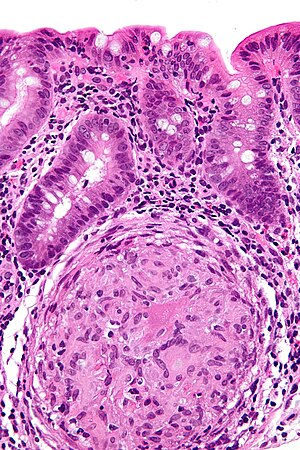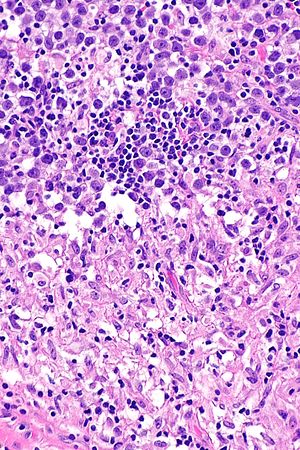Granuloma
A granuloma, also granulomatous inflammation, is a distinctive histomorphologic finding.
Granulomas can be elusive to the novice.
The plural of granuloma was granulomata; granulomas (an anglicized version) is, however, now generally accepted.
There is a specific disease called chronic granulomatous disease; it is dealt with in the chronic granulomatous disease article.
General
Definition of granuloma
- Many definitions exist.
- The term is used rather loosely by clinicans.
- Radiologists occasionally call small lung nodules "granulomas".
Strict pathologic definition
Robbins definition:
- Chronic inflammatory reaction characterized by the focal accumulation of activated macrophages, often with an epithelioid appearance.[1]
- "Epithelioid" cells = cells whose morphology resembles that of epithelial cells; the cells appear to adhere to one another.
Adams definition - it's short & sweet:
- A compact collection of macrophages.[2]
- The macrophages must form a small ball/cluster of cells, i.e. touch one another.
Other pathologic definitions include the presence of:[2]
- Plasma cells.
- Lymphocytes.
- Epithelioid macrophages.
Notes:
- The textbook answer for what is a granuloma is: "A collection of epithelioid macrophages."
- Granulomas are often associated with lymphocytes.
Etiologic classification of granulomas
- Infectious, e.g. tuberculosis, MAC, leprosy, syphilis, cat-scratch disease, schistosomiasis,[3] fungal infection.
- Neoplastic, e.g. seminoma, Lennert lymphoma,[4] ruptured ovarian teratoma,[5] Hodgkin lymphoma.[6]
- Autoimmune/inflammatory, e.g. Granulomatosis with polyangiitis (Wegener's granulomatosis), Eosinophilic granulomatosis with polyangiitis (Churg-Strauss syndrome).
- Allergic, e.g. hypersensitivity pneumonitis.
- Foreign body, e.g. pulmonary talcosis, silicosis, berylliosis,[3] suture material.
- Drug reaction.
- Idiopathic, e.g. sarcoidosis.
Notes:
- Memory device: DNF AAII = drug reaction, neoplasm, foreign body, allergy, autoimmune, idiopathic, infection.
- A long DDx for granulomas is complied by James.[7]
Microscopic
Features that assist one in finding granulomas
- Collection of cells that have abundant bubbly cytoplasm - most useful feature.
- Multinucleated giant cells - these are easy to identify if you've seen some before.
- Individual/singular multinucleated giant cells are not diagnostic of a granuloma... but should raise one's suspicion of one being present.
- Necrosis - too much pink (on H&E stained sections).
Notes:
- Small round collection of lymphocytes - without a capsule (as seen in lymph nodes).
- If there are no macrophages... it's a lymphoid nodule.
As a list
Features:[8]
- Foamy/bubbly cytoplasm, abundant - low power.
- Epithelioid morphology - cell borders near indistinct - key feature.
- "Footprint" pattern nuclei/bean-shaped nuclei - key feature.
- Macrophages usu. have an ovoid nucleus.
- +/-Nucleoli, small.
- +/-Fibrosis.
- +/-Palisading at edge.
DDx
- Reactive germinal centre - especially if there are abundant surrounding lymphocytes.[9]
Images
Granuloma due to MAC. (WC)
Granuloma with asteroid bodies. (WC)
Seminoma with granulomas - intermed. mag. (WC)
Cytology
Histologic classification of granulomas
- Necrosing (also caseating).
- More likely to be infectious.
- Examples: Tuberculosis (TB).
- Non-necrosing.
- Less likely to be infectious.
- Examples: Crohn's disease, sarcoidosis, drug reaction.
Whether necrosis is present in a granuloma is affected by the immune function, e.g. a HIV/AIDS patient may have non-necrosing granulomata due to TB.
Notes:
- A few people differentiate between caseating (fragments of recognizable tissue) and necrosing (dead debris only).[10]
- Infectious non-necrosing infections: Mycobacterium avium complex (MAC), cryptococcus, infections in immunosuppressed individuals.[10]
Special granulomas
Fibrin ring granuloma
- Classically associated with Q fever.
- Appearance:
- Epithelioid macrophages (i.e. a granuloma) surrounding a fibrin ring with a clear (lipid-filled) vacuole at its center.
- Images:
- Epithelioid macrophages (i.e. a granuloma) surrounding a fibrin ring with a clear (lipid-filled) vacuole at its center.
Naked granuloma
- Minimal (lymphoid) inflammation.
- Classically sarcoidosis [13][14] - DDx large.
Specific sites
Lung granulomas
There are many causes.[10]
Infectious:
- Myocbacterial: Tuberculosis, MAC, other.
- Fungal: Histoplasmosis, Cryptococcosis, Blastomycosis, Coccidioidomycosis.
- Aspiration pneumonia.
Non-infectious:
- Pneumoconioses/hypersensitivity pneumonitis: Talcosis, Berylliosis.
Idiopathic/autoimmune:
- Sarcoidosis.
- Granulomatosis with polyangiitis (Wegener's granulomatosis).
- Eosinophilic granulomatosis with polyangiitis (Churg-Strauss disease).
- Rheumatoid nodules.
Prostate granulomas
Stomach granulomas
Lymph node granulomas
Includes:
Skin granulomas
See also
References
- ↑ Cotran, Ramzi S.; Kumar, Vinay; Fausto, Nelson; Nelso Fausto; Robbins, Stanley L.; Abbas, Abul K. (2005). Robbins and Cotran pathologic basis of disease (7th ed.). St. Louis, Mo: Elsevier Saunders. pp. 82. ISBN 0-7216-0187-1.
- ↑ 2.0 2.1 Adams DO (1976). "The granulomatous inflammatory response. A review.". American Journal of Pathology 84 (1): 164–191. PMID 937513. http://www.ncbi.nlm.nih.gov/pmc/articles/PMC2032357/?tool=pubmed.
- ↑ 3.0 3.1 Mitchell, Richard; Kumar, Vinay; Fausto, Nelson; Abbas, Abul K.; Aster, Jon (2011). Pocket Companion to Robbins & Cotran Pathologic Basis of Disease (8th ed.). Elsevier Saunders. pp. 47. ISBN 978-1416054542.
- ↑ Summers, TA.; Rush, W.; Aguilera, N.; Lupton, G. (Oct 2009). "Cutaneous involvement in the lymphoepithelioid variant of peripheral T-cell lymphoma, unspecified (Lennert lymphoma). Report of a case and review of the literature.". J Cutan Pathol 36 Suppl 1: 25-30. doi:10.1111/j.1600-0560.2008.01203.x. PMID 19775391.
- ↑ Phupong, V.; Sueblinvong, T.; Triratanachat, S. (Nov 2004). "Ovarian teratoma with diffused peritoneal reactions mimicking advanced ovarian malignancy.". Arch Gynecol Obstet 270 (3): 189-91. doi:10.1007/s00404-003-0479-8. PMID 15526210.
- ↑ Al-Maghrabi, JA.; Sawan, AS.; Kanaan, HD. (Dec 2006). "Hodgkin's lymphoma with exuberant granulomatous reaction.". Saudi Med J 27 (12): 1905-7. PMID 17143374.
- ↑ James, DG. (Aug 2000). "A clinicopathological classification of granulomatous disorders.". Postgrad Med J 76 (898): 457-65. PMID 10908370.
- ↑ Santos, G. 26 January 2010.
- ↑ Iacobuzio-Donahue, Christine A.; Montgomery, Elizabeth A. (2005). Gastrointestinal and Liver Pathology: A Volume in the Foundations in Diagnostic Pathology Series (1st ed.). Churchill Livingstone. pp. 170. ISBN 978-0443066573.
- ↑ 10.0 10.1 10.2 El-Zammar, OA.; Katzenstein, AL. (Feb 2007). "Pathological diagnosis of granulomatous lung disease: a review.". Histopathology 50 (3): 289-310. doi:10.1111/j.1365-2559.2006.02546.x. PMID 17257125.
- ↑ Tjwa M, De Hertogh G, Neuville B, Roskams T, Nevens F, Van Steenbergen W (2001). "Hepatic fibrin-ring granulomas in granulomatous hepatitis: report of four cases and review of the literature". Acta Clin Belg 56 (6): 341–8. PMID 11881318.
- ↑ de Bayser L, Roblot P, Ramassamy A, Silvain C, Levillain P, Becq-Giraudon B (July 1993). "Hepatic fibrin-ring granulomas in giant cell arteritis". Gastroenterology 105 (1): 272–3. PMID 8514044.
- ↑ Brinster, NK. (Nov 2008). "Dermatopathology for the surgical pathologist: a pattern-based approach to the diagnosis of inflammatory skin disorders (part II).". Adv Anat Pathol 15 (6): 350-69. doi:10.1097/PAP.0b013e31818b1ac6. PMID 18948765.
- ↑ Noiles, K.; Beleznay, K.; Crawford, RI.; Au, S.. "Sarcoidosis can present with necrotizing granulomas histologically: two cases of ulcerated sarcoidosis and review of the literature.". J Cutan Med Surg 17 (6): 377-83. PMID 24138972.













